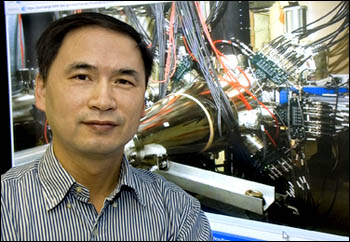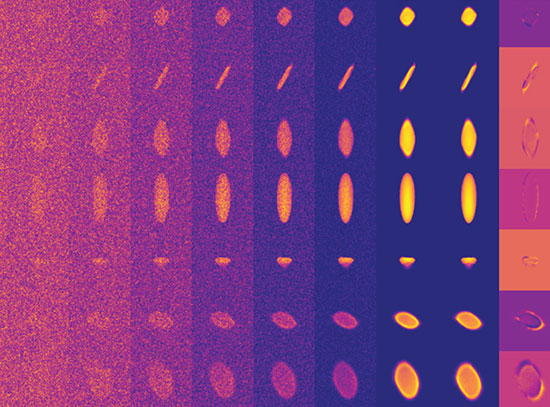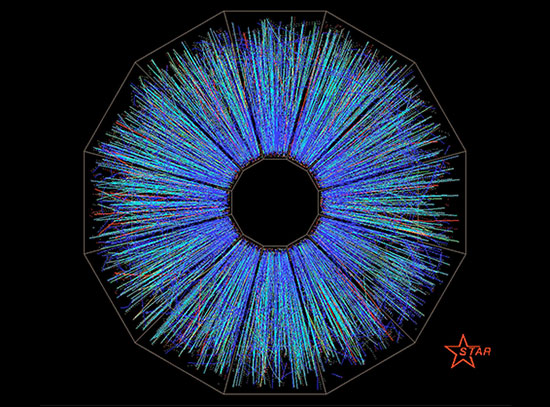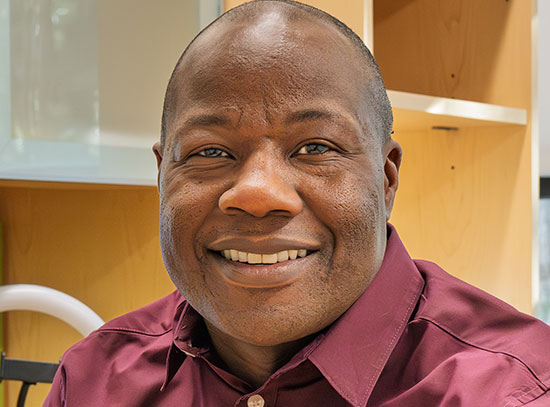Brookhaven Lab's Haixin Huang Receives Faraday Cup Award
June 30, 2006
UPTON, NY - Haixin Huang, a physicist at the U.S. Department of Energy's Brookhaven National Laboratory, and Kazuyoshi Kurita of Rikyo University, Japan, are the recipients of the 2006 Faraday Cup Award. The two scientists shared the $5,000 award, which was given by the Beam Instrumentation Workshop, an international forum on techniques for measuring charged particle beams produced in high energy accelerators, and donated by Bergoz Instrumentation of Saint Genis Pouilly, France, manufacturers of electronic instruments. The workshop was held at Fermi National Accelerator Laboratory this year.
The Faraday Cup Award is presented for outstanding contributions to innovative beam instrumentation. Huang and Kurita won the award for developing an instrument called a proton-carbon Coulomb Nuclear Interference (CNI) Polarimeter for use in Brookhaven's accelerator, the Relativistic Heavy Ion Collider (RHIC). The device measures the spin of protons that are accelerated in the collider.
"I am very pleased to be chosen for this award, along with my colleague, Kazuyoshi Kurita, who worked for the BNL-RIKEN Research Center at the time we were developing the polarimeter," Huang said. "The compact design of the polarimeter makes it economical, and it provides very precise measurements."
This year, RHIC is dedicated to understanding proton spin, as physicists collide beams of polarized protons - protons spinning in the same direction - at various collision energies. Physicists have believed that the spin of a proton, which is somewhat analogous to the Earth spinning on its axis, is the sum of the spin of its three component smaller particles called quarks. But experiments have shown that quarks account for only about 20 percent of the proton's spin. RHIC is the world's only machine capable of colliding high-energy beams of polarized protons, so it is a unique tool for helping to answer the question: What accounts for the missing 80 percent of the proton's spin? (More on spin physics at RHIC.)
The new polarimeter was developed in 1998 and tested at Brookhaven's Alternating Gradient Synchrotron (AGS), an accelerator that currently serves as an injector for RHIC. The CNI Polarimeter works by measuring the scattering pattern of protons after the beam hits a carbon target. Silicon detectors are used in a vacuum to measure the scattering of particles. Polarized protons reveal a certain symmetry that is proportional to the amount of polarization.
In the early 1990s, another type of polarimeter that measures subatomic particles called pions had been proposed to determine proton spin in RHIC. Brookhaven researchers working on the polarimeter design determined that the CNI Polarimeter had distinct advantages over the pion polarimeter.
"The CNI Polarimeter is faster and more efficient than the other method," said Huang. "It's easier to see carbon particles' scattering pattern, an indicator of proton spin - rather than pions - coming out of a carbon target. Also, silicon detectors that are used in our new method are more sensitive than the scintillator detectors used in a pion polarimeter. The CNI polarimeter provides fast and accurate measurements at all beam energies."
Haixin Huang earned a B.S. in physics from Shanxi University, Taiyuan, China, in 1982, and a Ph.D. in accelerator physics in 1995 from Indiana University. He took a postdoctoral position at Brookhaven Lab in 1995 and became an assistant physicist at the Laboratory in 1997. He is currently a physicist in the Lab's Collider-Accelerator Department.
NOTE TO LOCAL EDITORS: Haixin Huang is a resident of Centereach, NY.
2006-10509 | INT/EXT | Newsroom










